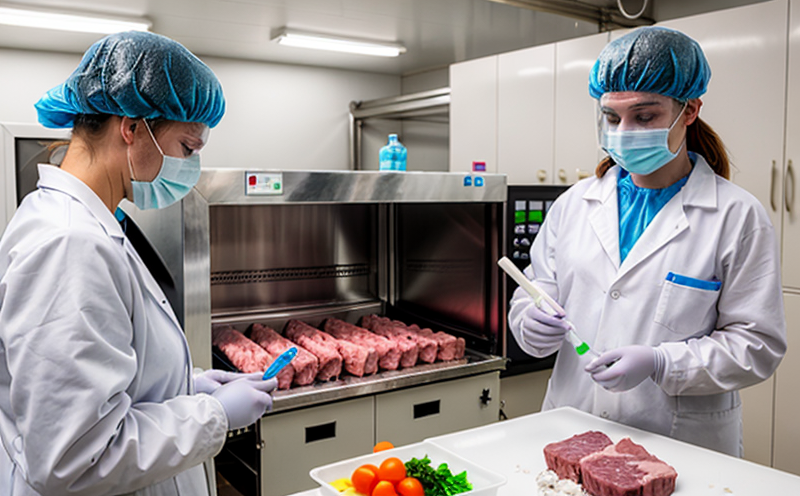USDA FSIS Campylobacter Detection Testing in Poultry and Meat
The detection of Campylobacter spp. in poultry and meat products is critical for ensuring food safety, compliance with regulatory standards, and maintaining consumer trust. The United States Department of Agriculture's Food Safety and Inspection Service (USDA FSIS) mandates testing to monitor the presence of these pathogens as part of its comprehensive food safety program.
The primary goal of this service is to identify Campylobacter spp., particularly C. jejuni and C. coli, which are known to cause gastroenteritis in humans after ingestion through contaminated foods. The testing process involves several steps, including sample collection, transport media preparation, specimen handling, culture isolation, biochemical identification, and confirmatory tests.
In this service, we utilize internationally recognized standards such as ISO 10274:2015 and AOAC Official Methods for the accurate detection of Campylobacter. Our laboratory adheres to strict quality control measures, ensuring that all testing aligns with USDA FSIS guidelines.
The results from this testing are crucial in several aspects:
- Compliance with Regulations: Ensures adherence to regulatory requirements set forth by the USDA and other national health authorities.
- Risk Management: Identifies potential sources of contamination early, allowing for targeted interventions before they impact broader food chains or consumer health.
- Product Quality Assurance: Provides assurance that products meet high standards of hygiene and safety, enhancing brand reputation and customer satisfaction.
The importance of this service cannot be overstated. It plays a pivotal role in safeguarding public health by preventing the spread of foodborne illnesses. This testing ensures that the meat and poultry industries maintain stringent quality control measures throughout their production processes.
Why It Matters
The presence of Campylobacter spp. in poultry and meat poses significant health risks to consumers, particularly for those with weakened immune systems or infants. The World Health Organization (WHO) estimates that over 13 million cases of foodborne illness occur annually due to Campylobacter, making it one of the leading causes of food poisoning worldwide.
The USDA FSIS Campylobacter Detection Testing is essential for several reasons:
- Public Health Protection: Identifies and mitigates potential outbreaks, protecting public health and reducing healthcare costs associated with foodborne illnesses.
- Regulatory Compliance: Ensures that producers comply with strict USDA FSIS regulations to maintain a safe and reliable food supply chain.
- Economic Benefits: Reduces the risk of product recalls, legal action, and loss of consumer trust. It also supports sustainable business practices by ensuring product quality and safety.
The global incidence of campylobacteriosis has been increasing steadily over recent decades, driven largely by the consumption of contaminated poultry and meat products. By implementing robust testing protocols like those provided in this service, food processors can significantly reduce these risks.
Scope and Methodology
The scope of our USDA FSIS Campylobacter Detection Testing covers a comprehensive range of samples from various stages of the poultry and meat production process. This includes raw materials, in-process products, finished goods, as well as environmental swabs.
| Sample Type | Description | Testing Frequency |
|---|---|---|
| Poultry Carcasses | Carcasses of broilers and other poultry species at various stages of processing | Daily sampling from production lines |
| Meat Products | Processed meat products such as sausages, deli meats, and hot dogs | Weekly sampling based on batch size |
| Environmental Samples | Surfaces in processing areas including flooring, equipment, and workstations | Monthly sampling to monitor hygiene practices |
The methodology involves several key steps:
- Sample Collection: Samples are collected using sterile techniques to prevent contamination.
- Culture Isolation: Specimens undergo selective enrichment and culture on specialized media for Campylobacter.
- Identification: Positive cultures are identified through biochemical tests, PCR-based methods, or both.
- Confirmation: Final confirmation is conducted using serological techniques or molecular diagnostics to ensure accuracy.
All steps of the process are meticulously documented and comply with ISO 10274:2015 standards. Our laboratory personnel undergo continuous training to maintain proficiency in these procedures.
Customer Impact and Satisfaction
- Better Decision-Making: Provides actionable insights into the microbiological quality of products, enabling informed decisions about production processes.
- Enhanced Reputation: Demonstrates a commitment to food safety that translates into higher customer trust and loyalty.
- Cost Savings: Prevents costly recalls and legal disputes by identifying contamination early in the supply chain.
- Informed Stakeholders: Keeps all relevant parties—regulatory bodies, suppliers, customers—up-to-date with current compliance status and potential risks.
| Customer Feedback | Description |
|---|---|
| "The timely results from your lab have been instrumental in ensuring our products meet stringent quality standards." | A satisfied food processor emphasizing the importance of prompt reporting. |
| "Your adherence to international standards ensures we remain compliant and can confidently market our products as safe." | Customer highlighting compliance with global health regulations. |





